Welcome to our blog post on high-density pistachio plantation! This article will explore the fascinating world of growing pistachios using high-density techniques. High-density planting is a modern approach that maximizes land utilization and increases yields. It involves planting pistachio trees in closer proximity, allowing for higher plant density per acre. By optimizing spacing, you can significantly boost your productivity. We will delve into the ideal spacing recommendations, the number of plants per acre, and the techniques employed.
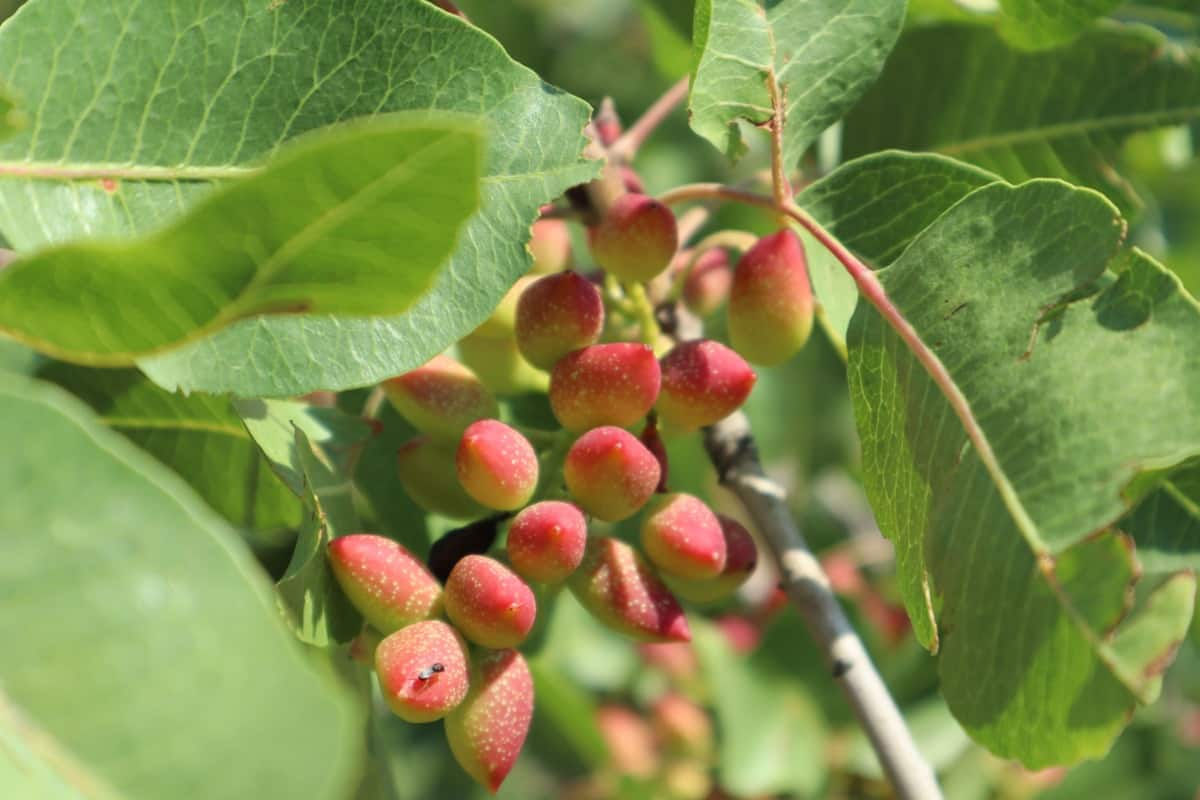
What is High-Density Pistachio Plantation?
High-density pistachio plantation is a modern technique that maximizes land utilization and increases productivity. It involves planting pistachio trees in closer proximity, allowing for higher plant density per acre. Farmers can effectively utilize available resources and achieve higher yields by optimizing tree spacing.
The ideal spacing recommendations for high-density pistachio planting vary but commonly, high-density ranges from approximately 4.5 to 5.5 meters between trees and 5 to 6 meters between rows. The most common spacing is 6-7 meters between rows and 5 meters between trees. This technique enables farmers to grow more pistachio trees per acre, increasing nut production and profitability.
Understanding More About Pistachio Plant Characters
Pistachio Basics
The pistachio (Pistacia vera), a member of the cashew family, is a small tree native to regions including Afghanistan, Central Asia, and Iran. Its seeds, commonly known as pistachio nuts, are widely consumed as food. Pistachio trees are well-suited to desert environments and can thrive in saline soils, tolerating water with high soluble salt content (3,000-4,000 ppm).
They exhibit hardiness within a temperature range of -10°C (14°F) in winter to 48°C (118°F) in summer. These trees prefer sunny positions and well-drained soil, while excessive humidity and poor drainage can lead to root rot.
Characteristics of Pistachio Trees
Pistachio trees can grow up to 10 meters tall and feature deciduous, pinnate leaves measuring 10-20 cm (3.9-7.9 inches). They are dioecious, separate male and female trees. The flowers lack petals and are unisexual, arranged in panicles. The Pistachio Fruit, The fruit of the pistachio tree, is a drupe that contains an elongated seed, the edible part we commonly refer to as a nut.
In case you missed it: High-Density Date Palm Plantation: Spacing, Plants Per Acre, Techniques, Cost, and Yield
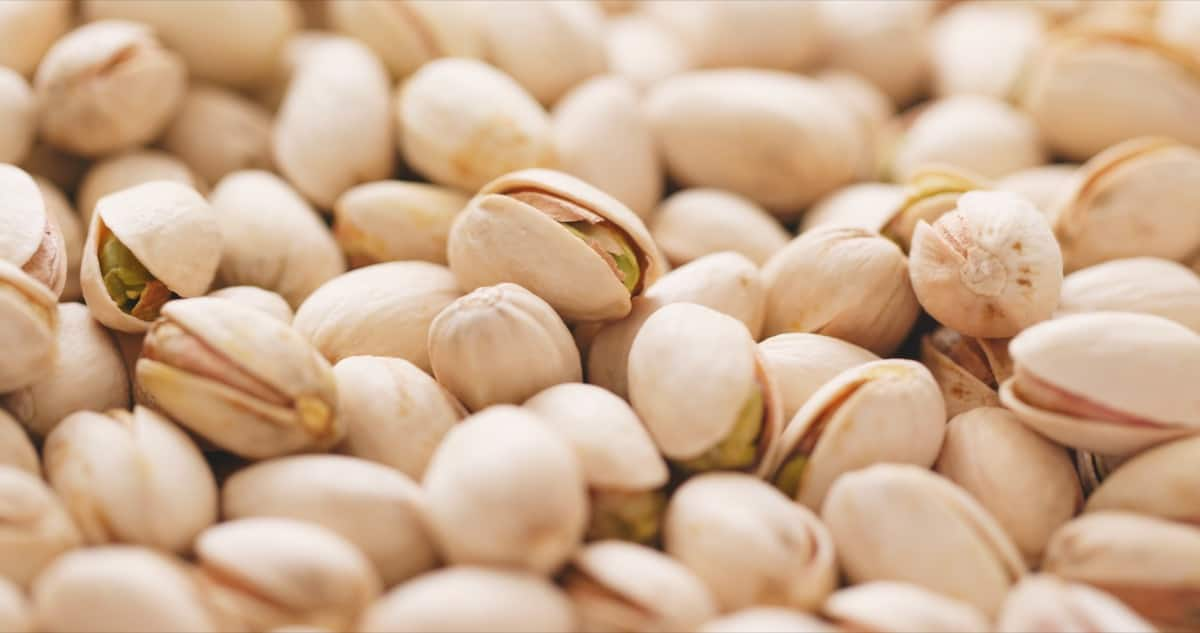
However, from a botanical perspective, it is a culinary nut. The fruit’s shell is hard and cream-colored, while the seed has a mauve-colored skin and light green flesh, offering a distinct flavor. As the fruit ripens, the shell changes color from green to yellowish-red, bursting open with an audible pop—a trait selected by humans. Commercial cultivars may vary in how consistently they split open.
Yield and Cultivation
Mature pistachio trees produce an average of around 50 kg (110 lb) of seeds, or approximately 50,000, every two years. These trees can live up to 300 years and are typically planted in orchards, taking 7 to 10 years to reach significant production. Pistachio trees exhibit alternate-bearing or biennial-bearing patterns, resulting in heavier harvests in alternate years. Peak production is typically achieved around 20 years of age.
Pruning helps maintain manageable tree sizes for easier harvesting. One male tree facilitates pollination for every 8 to 12 female trees. Harvesting methods involve shaking the drupes off the tree using specialized equipment. After hulling and drying, pistachios are sorted based on shell characteristics and further processed to obtain pistachio kernels.
Popular Pistachio Cultivar
In California, the ‘Kerman’ cultivar, originating from Kerman, Iran, is predominantly used for female pistachio trees. Scions from mature female ‘Kerman’ trees are grafted onto one-year-old rootstocks, ensuring consistent production and quality.
Benefits of High-Density Pistachio Plantation
- Increased Yield: High-density planting allows for more pistachio trees per acre, resulting in higher yield and greater profitability.
- Efficient Land Utilization: With closer spacing between trees, high-density planting optimizes land usage, maximizing the potential for cultivation and production.
- Enhanced Nut Quality: The controlled environment created by high-density planting promotes better airflow and sunlight penetration, improving nut quality and flavor.
- Reduced Water Consumption: The proximity of trees in high-density plantations creates a microclimate that reduces water evaporation, resulting in more efficient water usage and decreased irrigation requirements.
- Ease of Management: High-density plantations offer easier management and maintenance, as trees are closely spaced, allowing for convenient pruning, pest control, and harvesting operations.
- Early Production: Due to the higher planting density, high-density pistachio plantations tend to reach significant production levels earlier, reducing the time required for the trees to become economically productive.
- Pest and Disease Control: The compact nature of high-density plantations enables better monitoring and control of pests and diseases, resulting in improved crop protection and reduced losses.
- Optimal Resource Utilization: High-density planting allows for the efficient use of resources such as labor, fertilizers, and equipment, maximizing their effectiveness and reducing wastage.
In case you missed it: High-Density Gooseberry Plantation: Spacing, Plants Per Acre, Techniques, Cost, and Yield
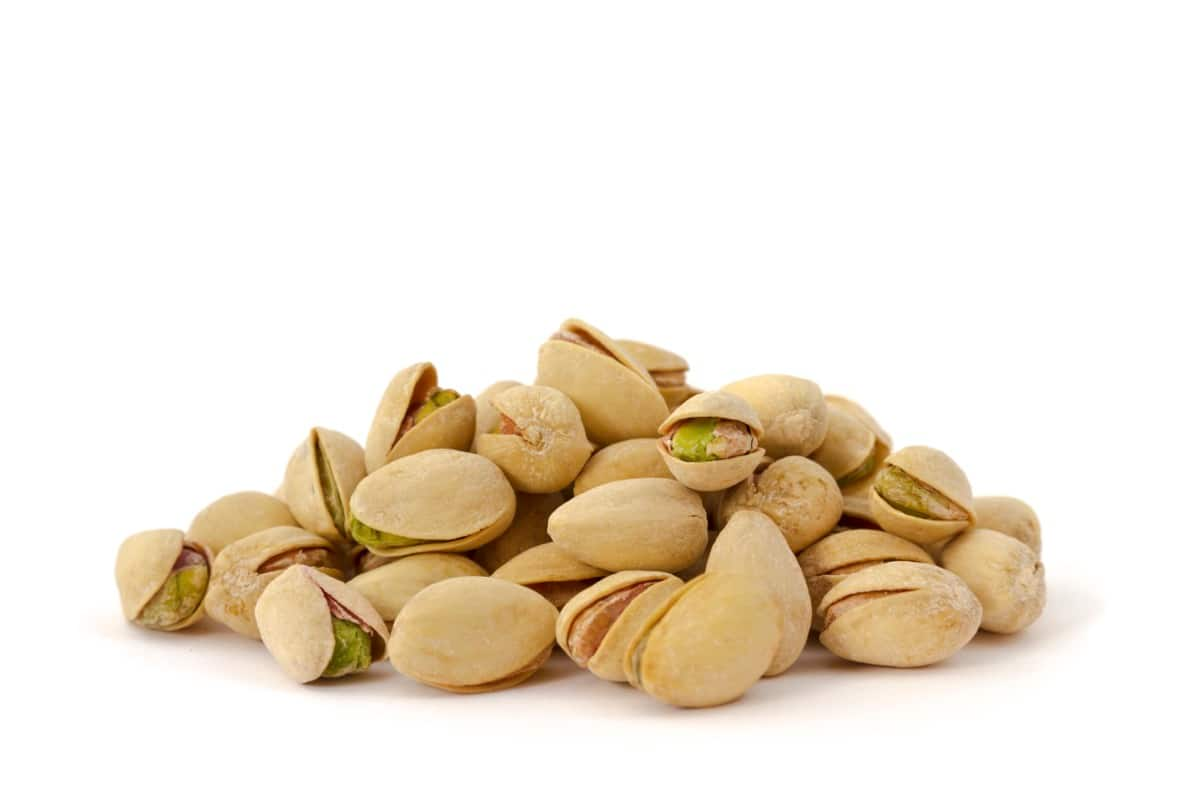
High-Density Pistachio Plantation Techniques
- Precise spacing and layout for optimal land utilization and productivity.
- Selection of compatible rootstocks for vigorous growth and disease resistance.
- Effective training and pruning methods maintain tree shape, promote sunlight penetration, and facilitate efficient harvesting.
- Advanced irrigation techniques like drip irrigation for targeted water delivery to the root zone.
- Nutrient management based on soil and foliar analysis for optimal tree health and nut production.
- Canopy management techniques (hedging, topping) for proper light distribution and pest/disease prevention.
- Integrated Pest Management (IPM) combines cultural, biological, and chemical controls for effective pest and disease management.
- Mechanized harvesting methods (trunk shakers, tree shakers) for improved efficiency and reduced labor costs.
Increasing Yield in High-Density Pistachio Plantation
The yield of pistachio nuts in high-density plantations is influenced by climate, cultivar selection, and effective crop management practices. On average, fully matured trees (after 10 to 12 years of budding) in high-density pistachio plantations can yield 8 to 10 kilograms per tree.
By implementing proper techniques such as precise spacing, advanced irrigation, nutrient management, and canopy management, farmers can optimize the yield potential of each tree and maximize production to 12-15 kg per tree. These practices and suitable cultivar choices increase yields and improve profitability in high-density pistachio plantations.
Sustainable and Best Practices for High-Density Pistachio Plantation
Climate Requirements
- Pistachio trees thrive in day temperatures above 36 °C and require cold winter months around seven °C for their dormant period.
- They are unsuitable for high elevations due to cool temperatures, but regions like Jammu & Kashmir in India are ideal for pistachio cultivation.
Soil Requirements
- Pistachio trees can adapt to various soils but prefer well-drained sandy loam soil.
- They are drought-tolerant but do not thrive in high-humidity areas.
- Soil pH between 7.0 to 7.8 is optimal for quality nut production, and they can tolerate a certain alkalinity level.
Land Preparation
- The land should be prepared by chiseling, plowing, and disking to achieve a fine tilth stage.
- Address hardpan issues to avoid water stagnation, as pistachio trees have deep roots.
Pistachio Propagation
- Propagate pistachio trees through budding onto suitable rootstocks raised in nurseries.
- Budding is typically done in the fall, and the budded trees are planted the same or the following year, depending on rootstock size.
In case you missed it: High-Density Dragon Fruit Plantation: Spacing, Plants Per Acre, Techniques, Cost, and Yield
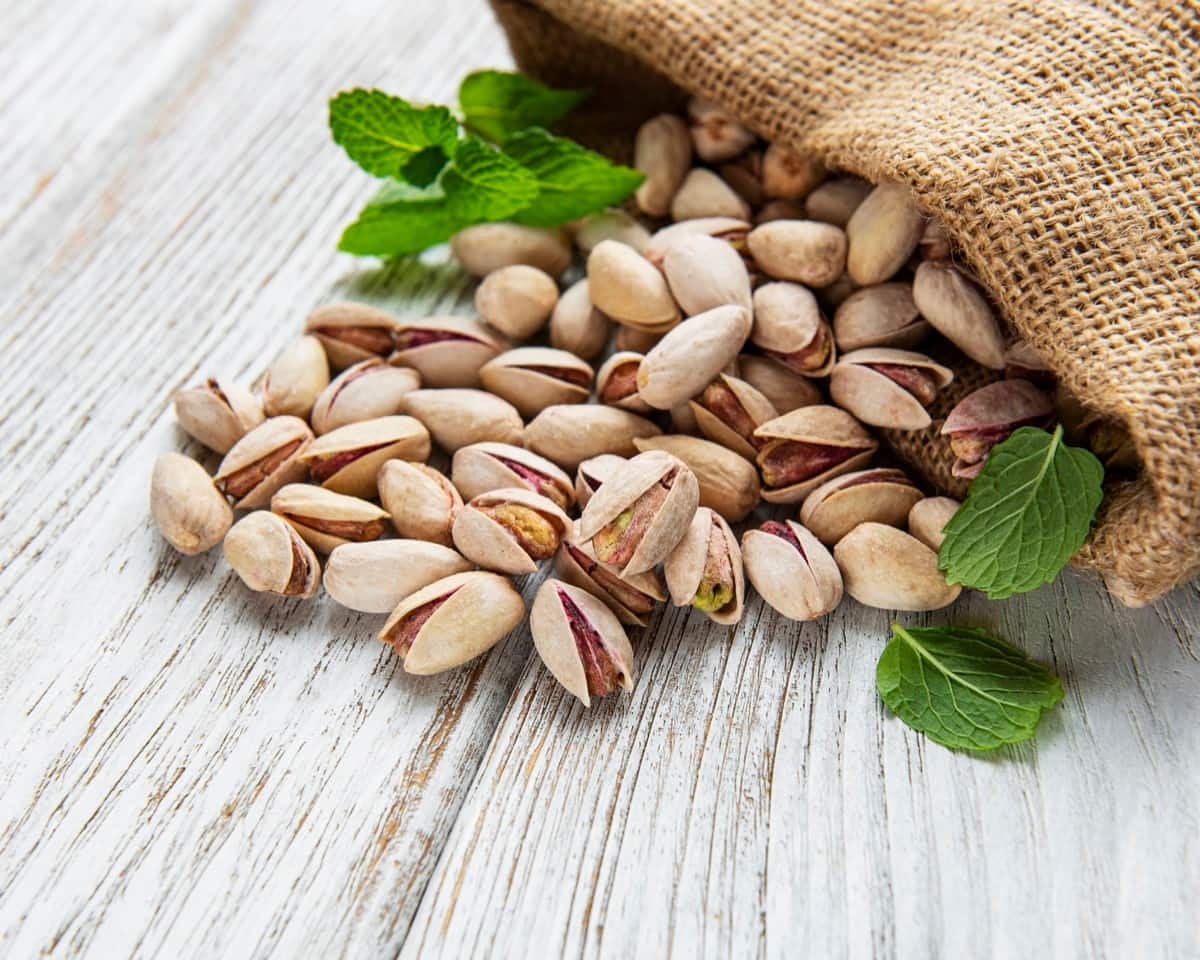
Pistachio Planting and Spacing
- Dig holes large enough to accommodate the roots, planting the tree 1 inch lower than in nurseries.
- Plant spacing depends on irrigation availability, with 6m x 6m for irrigated gardens and 8m x 10m where irrigation is limited.
- Maintain a ratio of 1 male tree to 8-10 female trees for proper pollination and nut production.
Pistachio Irrigation Requirements
- Although drought-tolerant, pistachio trees should receive sufficient moisture as needed.
- Mulching benefits water retention, and drip irrigation is recommended for efficient water utilization.
- Avoid water logging conditions, and irrigation may not be necessary during the rainy season.
Manures and Fertilizers
- Provide nitrogen fertilizer to meet the tree’s requirements, starting from the second year of planting.
- Apply ammonium sulfate at 450 grams per tree twice during the growing season.
- Provide 45-65 kg of actual nitrogen per acre in subsequent years, split into two doses.
Intercultural Operations
- Train the trees to grow upward and outward in a modified open-vase shape, keeping the center open for sunlight penetration.
- Remove secondary branches through thinning operations, and minimize pruning cuts once the tree framework is established.
- Implement weed control measures to prevent competition for nutrients, including herbicide treatments and mulching.
Pests and Diseases
- Common pests include mites, stinkbugs, and leaf-footed plant bugs, while diseases can include powdery mildew, rust, and various blights.
- Consult local horticulture departments for symptoms and control measures specific to your region.
Harvesting Pistachios
- Expect significant crop yields around the 7th or 8th season, with maximum production achieved around the 12th year.
- Harvest when the hull easily separates from the shell, typically occurring over 6 to 10 days.
- Avoid harvesting underdeveloped kernels for optimal nut quality.
Pistachio Crop Yields
- The yield of pistachio nuts depends on climate, cultivar selection, and crop management practices.
- On average, fully matured trees (after 10 to 12 years of budding) can yield 8 to 10 kilograms of nuts per tree.
In case you missed it: High-Density Lemon Plantation: Spacing, Plants Per Acre, Techniques, Cost, and Yield
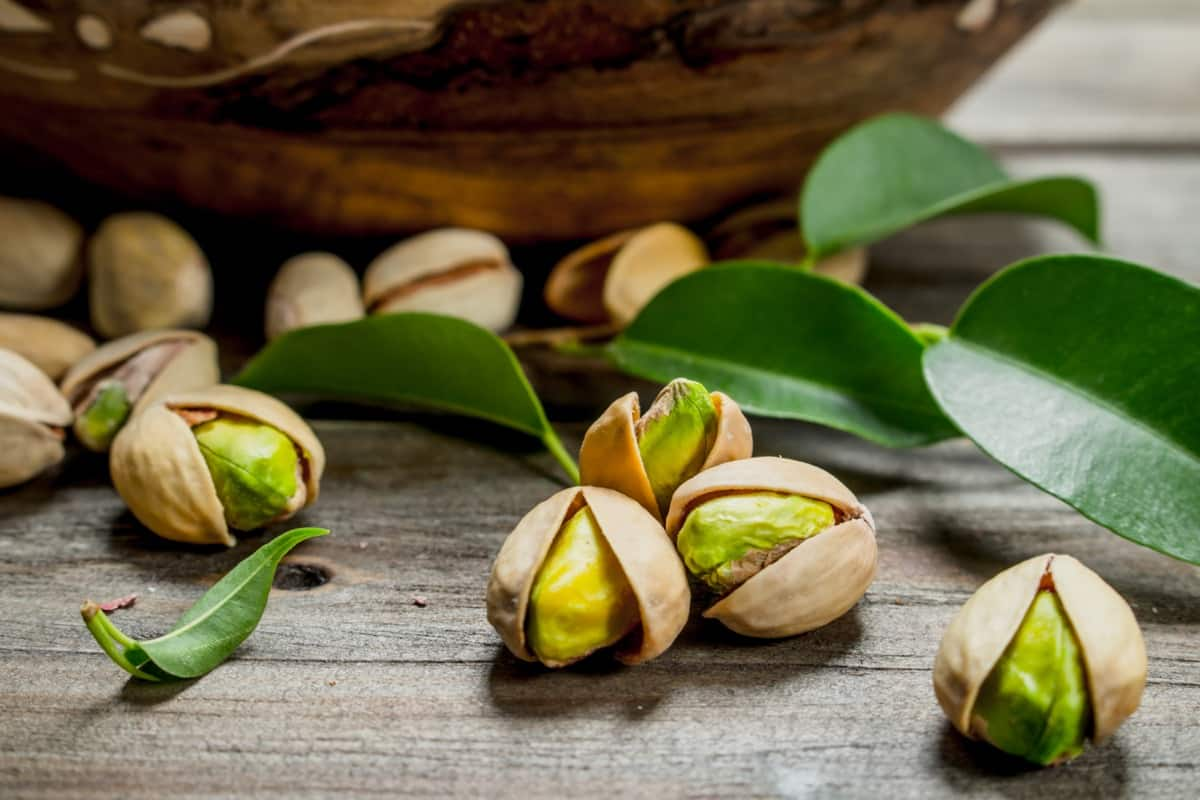
High-Density Pistachio Plantation Spacing
- Planting Depth: When planting pistachio trees, dig holes large enough to accommodate the roots and ensure the tree is positioned 1 inch lower than its nursery level.
- Spacing Based on Irrigation Availability: The spacing of trees depends on the availability of irrigation. A spacing of 4 meters by 4 meters or 6 meters by six gardens is recommended for irrigated high-density gardens. Plant per acre is 120 to 240 trees. Wider spacing of 8 meters by 10 meters is suitable in areas with limited irrigation. Plant per acre 57 trees.
- Male-to-Female Ratio: To facilitate proper pollination and nut production, it is advised to maintain a ratio of 1 male tree to 8-10 female trees in the plantation.
High-Density Pistachio Plantation Varieties
The Kerman variety, known for its large nuts and high yield potential, is widely cultivated. Peters exhibits resistance to late spring frosts, while Lost Hills is a high-yielding variety often used for pollination. Golden Hills stands out for its early maturity and attractive golden kernels, while Sfax offers excellent resistance to Verticillium wilt.
Among Indian varieties, Jammu adapts well to the climate of Jammu and Kashmir, Kaghzi is valued for its thin, easily peelable shells, Sirora produces medium-sized nuts with high oil content, and Peshawari thrives in arid regions. Choosing the right varieties based on climate, yield potential, disease resistance, and market demand is vital for successful and profitable cultivation.
High-Density Pistachio Plantation Irrigation
High-density pistachio plantations rely on appropriate irrigation practices for optimal growth and yield. While pistachio trees can tolerate drought, they are vulnerable to water stagnation. Consistent irrigation with high-quality water is necessary throughout the year, with a water requirement of 11 to 13 megaliters per hectare during the growing season. Dry summers are essential to avoid harm to nut maturation. Balancing irrigation and preventing waterlogging or excessive rainfall at critical growth stages are vital for successful high-density pistachio cultivation.
High-Density Pistachio Plantation Pruning Methods
Proper pruning is crucial for high-density pistachio plantations to ensure healthy growth and maximize yields. It involves removing broken and dead branches and training young trees for desired shapes. Before planting, the soil is prepared, and irrigation systems are set up. Weed-free tree lines are established to ease the planting process.
Cultivated in pots, nursery trees are transplanted carefully, settling slightly lower than their nursery position. In high-density plantations, pistachio trees are spaced 6 meters × 6 meters, allowing efficient pruning and weeding. A ratio of 1 male tree to 8 female trees is recommended to enhance nut production.
Optimal Fertilization for High-Density Pistachio Plantation
Proper fertilization is vital for high-density pistachio plantations. Nitrogen is a crucial nutrient, similar to other nut trees. However, fertilizers should be avoided during the first year of planting. In subsequent years, each pistachio tree should receive 450 grams of ammonium sulfate in two split doses during the growing season. A nitrogen application of 45 kg to 65 kg per acre is recommended for mature trees, divided into two splits throughout the growing season.
High-Density Pistachio Plantation Disease and Pest Control
High-density pistachio plantations face potential threats from pests such as mites, stinkbugs, leaf-footed plant bugs, and diseases like powdery mildew, rust, and Alternaria late blight. One particular concern is panicle and shoot blight caused by the fungus Botryosphaeria, which can devastate flowers and young shoots, endangering entire orchards.
In case you missed it: High-Density Litchi Plantation: Spacing, Plants Per Acre, Techniques, Cost, and Yield
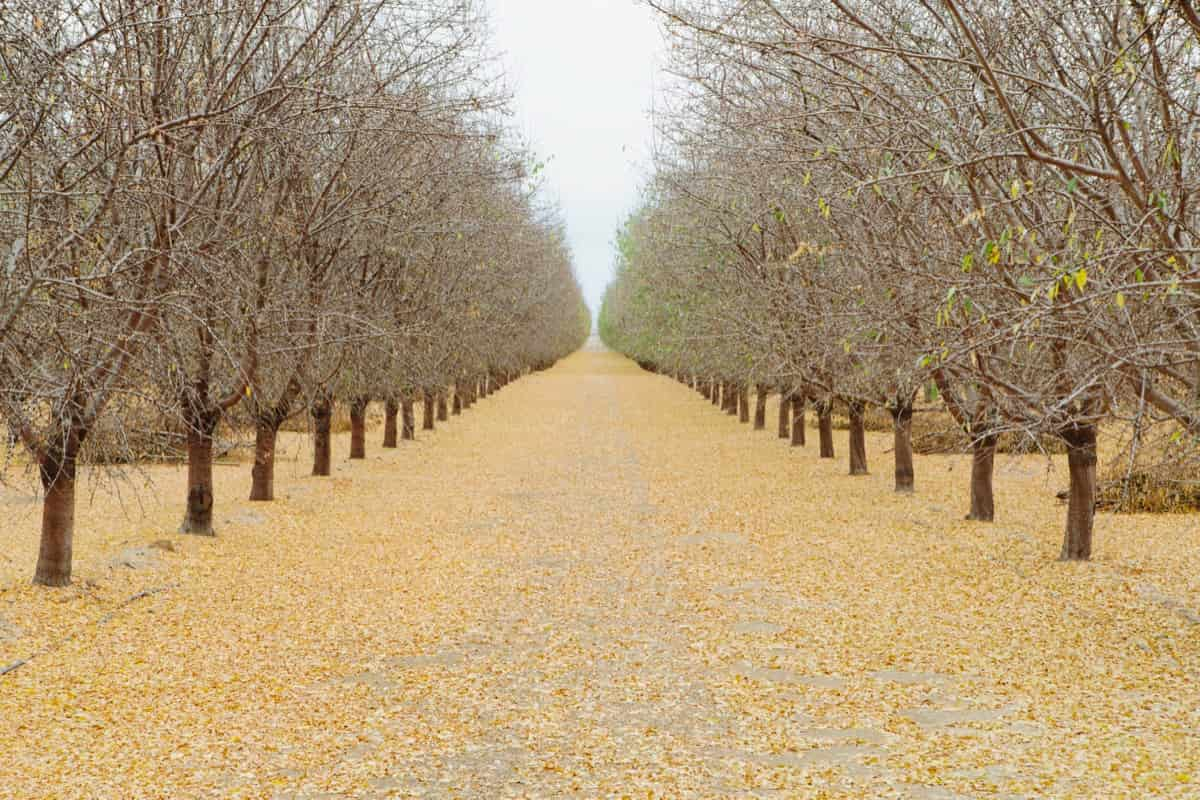
California’s pistachio industry encountered blight, and 50% pistachio harvest was lost to anthracnose fungus. Effective pest and disease management practices are vital for safeguarding high-density pistachio plantations and ensuring productive yields.
High-Density Pistachio Plantation Harvesting Tips
Harvesting pistachios from high-density plantations requires careful consideration and proper timing. Pistachio trees take several years to reach full production potential, typically around 12 years after planting. Maturity can be identified when the hull easily separates from the shell, lasting 6 to 10 days. Harvesting should avoid underdeveloped kernels.
For a high-quality crop, pistachios are best harvested within a 2- to 3-week period. Availability of harvest equipment, labor, and processing and storage facilities is crucial during this time. The “shake and catch” method involves mechanical tree shakers and catching frames to collect the nuts. However, this method can damage young trees, so care should be taken when knocking the pistachios onto tarps using mallets and poles.
High-Density Pistachio Plantation Cost Analysis (1 Acre Basis)
- Pre-Planting (Year 1): Costs for backhoe, soil analysis, plowing, ripping, discing, weed control, and irrigation layout totaled $756.
- Planting: Expenses for surveying, tree costs, staking, and planting amounted to $1,900.
- Cultural (Years 2-6): Costs for irrigation, weed control, training, vertebrate control, fertilization, pruning, and insect control varied from $698 to $1,493 per year.
- Harvest: Harvest costs, including shaking, catching, hauling, and the California Pistachio Research Board assessment, amounted to $274.
- Total Costs/Acre: Ranged from $5,399 to $3,762 annually.
- Net Profit/Acre Above Total Costs: Varied from $5,399 to $19,872 annually.
Note: Cost can vary depending on location, market conditions, and farm management practices.
Conclusion
High-density pistachio plantation, optimal spacing is around 5m x 6m between trees, resulting in approximately 160-180 plants per acre. Utilizing techniques like grafting, pruning, and efficient irrigation can maximize yield. Initial setup costs vary but can yield profitable returns in the long term.
- Types of Pesticides Used in Agriculture: A Beginner’s Guide
- Economical Aquaculture: A Guide to Low-Budget Fish Farming
- 15 Common Planting Errors That Can Doom Your Fruit Trees
- How to Make Houseplants Bushy: Effective Tips and Ideas
- Innovative Strategies for Boosting Coconut Pollination and Yield
- Pollination Strategies for Maximum Pumpkin Yield
- The Complete Guide to Chicken Fattening: Strategies for Maximum Growth
- Natural Solutions for Tulip Problems: 100% Effective Remedies for Leaf and Bulb-Related Issues
- Revolutionizing Citrus Preservation: Towards a Healthier, Greener Future
- Natural Solutions for Peony Leaf and Flower Problems: 100% Effective Remedies
- Maximizing Profits with Avocado Contract Farming in India: A Comprehensive Guide
- Natural Solutions for Hydrangea Problems: 100% Effective Remedies for Leaf and Flowers
- The Ultimate Guide to Choosing the Perfect Foliage Friend: Bringing Life Indoors
- From Sunlight to Sustainability: 15 Ways to Use Solar Technology in Agriculture
- The Ultimate Guide to Dong Tao Chicken: Exploring from History to Raising
- The Eco-Friendly Makeover: How to Convert Your Unused Swimming Pool into a Fish Pond
- Mastering the Art of Delaware Chicken Farming: Essentials for Healthy Backyard Flocks
- 20 Best Homemade Fertilizers for Money Plant: DIY Recipes and Application Methods
- How to Craft a Comprehensive Free-Range Chicken Farming Business Plan
- Brighten Your Flock: Raising Easter Egger Chickens for Beauty and Bounty
- How to Optimize Your Poultry Egg Farm Business Plan with These Strategies
- Subsidy for Spirulina Cultivation: How Indian Government Schemes Encouraging Spirulina Farmers
- Ultimate Guide to Raising Dominique Chickens: Breeding, Feeding, Egg-Production, and Care
- Mastering the Art of Raising Jersey Giant Chickens: Care, Feeding, and More
- Ultimate Guide to Raising Legbar Chickens: Breeding, Farming Practices, Diet, Egg-Production
- How to Raise Welsummer Chickens: A Comprehensive Guide for Beginners
- How to Protect Indoor Plants in Winter: A Comprehensive Guide
- Ultimate Guide to Grow Bag Gardening: Tips, Tricks, and Planting Ideas for Urban Gardeners
- Guide to Lotus Cultivation: How to Propagate, Plant, Grow, Care, Cost, and Profit
- Agriculture Drone Subsidy Scheme: Government Kisan Subsidy, License, and How to Apply Online
- Ultimate Guide to Raising Araucana Chickens: Breed Profile, Farming Economics, Diet, and Care
- Bringing Hydroponics to Classroom: Importance, Benefits of Learning for School Students
- Ultimate Guide to Raising Polish Chickens: Breed Profile, Farming Economics, Diet, and Care
- Ultimate Guide to Raising Australorp Chickens: Profile, Farming Economics, Egg Production, Diet, and Care
- Silkie Chicken Farming: Raising Practices, Varieties, Egg Production, Diet, and Care
- Sussex Chicken Farming: Raising Practices, Varieties, Egg Production, Diet and Care